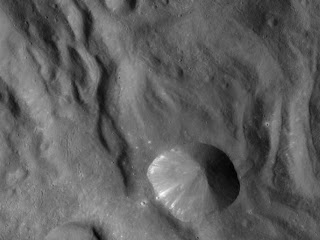 |
| Giant Asteroid Vesta (NASA) |
Dawn duty is to obtain high-resolution images of the surface uneven, crater and make other scientific measurements. "Dawn's data thus far have revealed the rugged topography and complex textures of the surface of Vesta, as can be seen in this video," said Carol Raymond, deputy principal investigator at NASA's Jet Propulsion Laboratory, Pasadena, Calif. "Soon, we'll add other pieces of the puzzle such as the chemical composition, interior structure, and geologic age to be able to write the history of this remnant protoplanet and its place in the early solar system."
The plan, Dawn at Vesta for one year, after that Dawn will leave for the dwarf planet Ceres in July 2012. The journey from Vesta to Ceres is expected to spend time over three years, meaning that Dawn will arrive at Ceres in 2015.
Dawn's mission to Vesta and Ceres is managed by JPL for NASA's Science Mission Directorate in Washington. JPL is a division of the California Institute of Technology in Pasadena. Dawn is a project of the directorate's Discovery Program, managed by NASA's Marshall Space Flight Center in Huntsville, Ala. UCLA is responsible for overall Dawn mission science. Orbital Sciences Corp. in Dulles, Va., designed and built the spacecraft. The German Aerospace Center, the Max Planck Institute for Solar System Research, the Italian Space Agency and the Italian National Astrophysical Institute are international partners on the mission team.
From the observation that observed by Dawn is the existence of a group of mysterious linear ridges and valleys. To find out how Dawn take the data while doing exploring Vesta, NASA has made a video about Dawn when exploring Vesta. "If you want to know what it's like to explore a new world like Vesta, this new video gives everyone a chance to see it for themselves," Jaumann said. "Scientists are poring over these images to learn more about how the craters, hills, grooves and troughs we see were created."
Source: NASA

Post a Comment